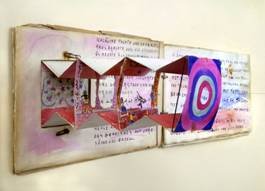The architecture in books
dal 6/12/2006 al 14/3/2007
Segnalato da
6/12/2006
The architecture in books
Pinakothek der Moderne, Munich
Fictive buildings and cities in literature. Fictive architecture is an important part of world literature. The exhibits include personal sketches by Gottfried Keller, Gustave Flaubert, Theodor Fontane, Heinrich Mann, J.R.R. Tolkien, William Faulkner, Friedrich Durrenmatt, Vladimir Nabokov, Gunter Grass and Umberto Eco, in which the authors attempt to translate their spatial ideas graphically onto paper.

Fictive buildings and cities in literature
Fictive architecture is an important part of world literature. The exhibits include personal sketches by Gottfried Keller, Gustave Flaubert, Theodor Fontane, Heinrich Mann, J.R.R. Tolkien, William Faulkner, Friedrich Durrenmatt, Vladimir Nabokov, Gunter Grass and Umberto Eco, in
which the authors attempt to translate their spatial ideas graphically onto paper. One section of the exhibition deals with the connex between
architecture and text in comics, another pursues the themes of the rooms
imagined by Francois Rabelais, John Milton, E.T.A. Hoffmann, Adalbert
Stifter, Franz Kafka or Thomas Bernhard. Collaboration with the Chair for
Urban Planning and Development at the TU Munich has resulted in models based
on descriptions of fictive cities. They represent Campanella’s City of the
Sun, Goethe’s Padagogic Province and George Orwell’s "1984". The exhibition
focuses on the way fictive buildings have stimulated architects and artists
to create drawings, paintings and sculptures, and how on occasions something
real can emerge from the architecture of an author’s dreams or imagination -
as, for instance, with the Citta' ideale built in Umbria by the architect
Tomaso Buzzi on the lines of the fantasy city from the world of literature.
Further examples are Wilhelm Hauff’s Burg Lichtenstein, the castle in
Wurttemberg based on the novel of the same name, or the white city taken
from Emile Zola’s "Travail", part of which Tony Garnier realised in Lyon.
Through drawings, models and computer simulations the exhibition presents
fictive architecture from two millennia. The materialisation of poetic
castles in the air helps us to penetrate more deeply the worlds and rooms of
the poets and also enables us to find our way more easily through the
labyrinths of fictive buildings and cities. In a letter to the publishing
house Rowohlt Verlag in 1950, the author Arno Schmidt fittingly described
the importance of knowing exactly what the rooms of the writer looked like:
"What I miss - with regret and curiosity - in all stories of fiction is the
fact that the writer does not give the reader his vision of rooms and space.
Yet, given that the reader will always place the setting in a curious world
of his own, would it not be of great value to find out how the poet himself
has imagined these localities?!"
For this display, the exhibition has assembled around 400 exhibits from
international museums, archives and collections. They consist of paintings,
works on paper, sketches, books, sculptures, animated films and numerous
models that have been especially made to be able to visualise literary rooms
and cities. Among the particular highlights are sketches being shown for the
very first time. They include those by Umberto Eco for his novel "The Name
of the Rose", the originals of the Belgian artists Schuiten and Peeters for
the comic strip "The mysterious cities of the Fantastic" and Karl Friedrich
Schinkel’s painting "The city by the river" from the Alte Nationalgalerie in
Berlin, which the architect painted in response to an art contest with the
writer Clemens Brentano.
Accompanying the exhibition is a catalogue published by Anton Pustet Verlag
Salzburg. It has 568 pages and 380 colour illustrations, and is on sale in
the museum shop at the price of 39 Euros. It presents by way of 120 examples
from world literature, 15 essays and a text by Martin Mosebach "Architektur
wie sie im Buche steht" ("The architecture of fiction").
Accompanying programme in the Bavarian Academy of the Fine Arts,
Max-Joseph-Platz at 7 p.m.
01.02.2007: Discussion on architecture and literature with Friedrich
Achleitner, Eugen Gomringer, Gert Heidenreich, Stefan Huber, Martin Mosebach
08.02.2007: Lecture and reading by Gunter Kunert
22.02.2007: Lecture by Prof. Dr. Werner Frick, "In der Asphaltstadt bin
ich daheim": Urbane Szenarien in der Literatur der klassischen Moderne, "I
am at home in the asphalt city": Urban scenarios in Classic Modern
Literature
Press preview: December 07, 11.00
Exhibition opening: December 07, 19.00
Pinakothek der Moderne
Barer Str. 29 - Munich



